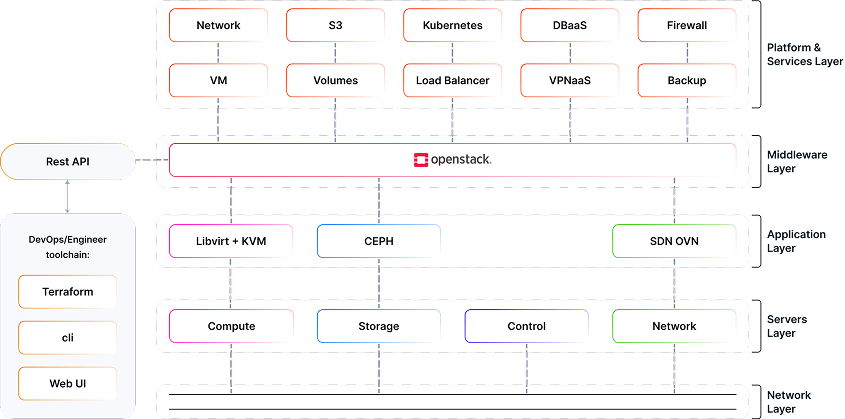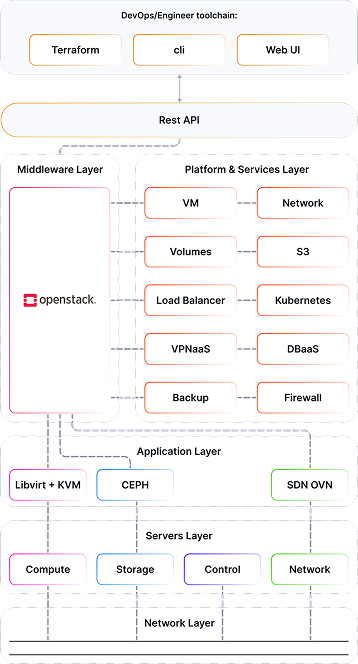Let’s start with the obvious: public cloud isn’t cheap anymore. It offers plenty of services, but for most companies it’s unpredictable, hard to budget, and often bloated with hidden costs — especially on scaled workloads. Over 8 in 10 organizations using public clouds regularly exceed their budgets. Hidden fees, unpredictable egress costs, and billing complexities are top reasons for this.
As businesses grow, cost unpredictability isn’t just an inconvenience — it becomes a serious roadblock. Public cloud pricing shifts, vendor lock-in tightens its grip, and shared performance bottlenecks start affecting critical workloads. Frustration builds.
Options shrink.
On the other hand, private cloud promises control but demands deep technical expertise to manage software, hardware, and networking. It’s a trade-off: flexibility versus complexity. For companies that want the best of both worlds — private cloud built on OpenStack is a strong alternative. But what does a private cloud with OpenStack really mean, how does it function, and when should you consider it? Let’s dive into the specifics.
Why are teams moving towards this model?
Unlike public cloud environments, the hardware in a private cloud is entirely dedicated to a single organization. This is particularly critical for highly regulated industries like finance, healthcare, and government, where maintaining complete control over infrastructure is non-negotiable. These sectors handle vast amounts of sensitive data and must adhere to stringent compliance requirements, making the dedicated nature of private clouds a necessity.
Private cloud providers go beyond basic infrastructure management. They monitor key performance metrics such as CPU and memory utilization, network throughput, and disk /0 latency- in real time to ensure optimal system and application performance. Additionally, they take on the burden of proactive patch management and hardware maintenance, freeing internal teams to focus on strategic priorities.
What makes the difference between good and bad private clouds?
The hardware. Your private cloud’s performance and scalability are tied to hardware design choices. Choosing a provider that employs substandard hardware or makes poor hardware choices can lead you down the steep road of nonstop performance bottlenecks, downtime during scaling, etc. That said, top hardware design features to consider are:
- Usage Models: Use full dedicated resources of the bare metal for high-performance high-security workloads. Or use VMs within hardware abilities for general-purpose workloads where immediate scaling is more important.
- Storage Design: The choice of hardware combined to build your storage impacts application speed. For example, NVMe SSDs deliver fast data transfer speeds for storage applications. When deployed in Ceph clusters, NVMe SSDs significantly improve performance and minimize latency, particularly for high IOPS workloads.
- Networking: Networking technologies play important roles, especially in latency-sensitive workloads. For example:
- Multi-pathing boosts performance for high throughput workloads like AI, gaming, and big data analytics. It also prevents performance bottlenecks and downtime by routing traffic dynamically.
- Software-defined networking (SDN) enables dynamic control over networks, devices, and traffic/load balancing. It also enables flexible network segmentation.
- Redundancy & Failover: The ability to switch between multiple hardware options when one fails is key. Strategies for implementing redundancy and failover include:
- Multi-site disaster recovery options: Can be active-active for high-availability workloads or active-passive for workloads where a little latency (during which traffic is redirected to a backup server) is acceptable.
- Real-time replication strategies: This can be synchronous (copying to main, then replica servers) or asynchronous (copying to main and replica servers simultaneously).
Why OpenStack matters?
OpenStack is a framework. It lets you assemble infrastructure services on your terms. What makes OpenStack a better choice than proprietary solutions for a private cloud?
Cost Structure
Hardware Agnosticism
Built-in Automation
No Lock-In
What core services does OpenStack provide?
Openstack offers a modular series of interconnected or projects, similar to what’s typically found on hyperscale clouds. The OpenStack services have a modular architecture that lets you get creative with choosing the specific projects to deploy in your stack for compute, hardware, storage, networking, and more:
Compute
The OpenStack service for compute is Nova, used for provisioning and managing servers. Nova orchestrates VMs, bare metals (when Nova’s paired with Ironic), and containers (though containers are primarily managed via Magnum or Zun).
Storage
OpenStack provides a number of private cloud storage options, including:
Cinder: Provides persistent block storage for VMs, and includes storage QoS for improved performance.
Swift: A high-availability low-cost object/blob storage solution for large volumes of unstructured data. Swift is compatible with S3 APIs, making it great for hybrid/multi-cloud deployments and data migration. It also has flexible concurrency controls which is great for performance when multiple operations are being performed simultaneously.
Ceph: A fault-tolerant shared file storage (comprising object, block, and file interfaces), great for hyper-converged infrastructure.
Networking
The networking project for OpenStack is Neutron — responsible for setting up the virtual network infrastructure. Neutron includes specialized functions like Firewall-as-a-Service (FWaaS), Load Balancer-as-a-Service (LBaaS), and VPN-as-a-Service (VPNaaS).
With these components accessible through a series of agents, plugins and drivers, Neutron implements dynamic software-defined networking (SDN) and allows for distributed virtual routing (DVR) when L3 agents run directly on compute nodes.
Identity & Access Management (IAM)
Keystone is the OpenStack IAM project responsible for all authentication, authorization and service discovery. It supports token generation and storage; user identity creation and storage; role assignment and role-based access control (RBAC), and endpoint/project storage.
Its authentication and authorization controls allow for building secure multi-tenant services in isolated environments.
Monitoring & Metrics
The OpenStack Telemetry Service collects monitoring data to provide real-time insights into workloads and system health. It collects events and notifications published by various projects, and also polls APIs and infrastructure for monitoring data that isn’t directly emitted, offering instant visibility for fast anomaly detection and capacity planning.


Security in a private cloud: who controls what?
Security is one of the most important benefits of private clouds, providing features such as:
- Full Isolation: private cloud providers ensure hardware-level segregation — servers are tenant-exclusive, reducing the risk of unauthorized access to sensitive infrastructure and data.
- Network Segmentation: Service providers handle network segmentation, setting up VLANs and VXLANs to isolate customer traffic. However, organizations still need to manage workload segmentation within their private networks to reduce lateral movement risks and boost performance.
- End-to-End Encryption: Providers are responsible for infrastructure-layer encryption, including encrypting hard drives, private networks, backups, etc. Customers are responsible for data encryption, e.g. implementing TLS/HTTPs to secure data in transit and encrypting data before storage.
Also, enterprises can employ custom algorithms to encrypt data without relying on third-party cloud providers. This way, enterprises get dedicated encryption keys and retain absolute control of the keys — unlike in
public clouds.
- Access Control & Compliance: Providers manage infrastructure-level compliance and access, including getting certifications from bodies like SOC, NIST, and FedRAMP. Enterprises take charge of ensuring workload compliance and defining access controls (via mechanisms like RBAC).
- Network Security: Providers manage features like firewalls and load balancing. They also offer built-in intrusion detection and anomaly detection and response. These include monitoring network traffic for anomalies, applying firewall rules to block malicious traffic, and implementing DDoS scrubbing to mitigate DDoS attacks.
PS: The offerings discussed are the ideal security features a provider should offer; customers must ask questions and compare offerings before committing to any vendor.
Who should consider a private cloud with OpenStack?
Despite its long-term cost-savings, performance, and security benefits, a private cloud is only best-fit for you if:
- You’re running high-performance, always-on applications like iGaming platforms, Marketing Intelligence, Video Streaming services, high-frequency trading (HFT) systems, AI/ML inference workloads and so on, where 24/7 availability is strictly required.
- You need a hybrid cloud strategy that combines private cloud for stable, cost-efficient workloads, and public cloud for backup storage or emergency scaling when demand spikes, like during a Black Friday sale.
- You want to avoid or are tired of unpredictable public cloud bills and vendor lock-in.
Is Private Cloud with OpenStack right for you?
If you’re looking to avoid vendor lock-in and accurately predict your cloud costs, or if improved performance, control, and security are critical to you, then a private cloud with OpenStack is worth considering.
But not just any private cloud provider will do. You need the right provider to help you actualize the numerous benefits of a private cloud with OpenStack.
For this, Advanced Hosting, with 22 years of experience building custom infrastructures, is definitely the best at delivering high-performance solutions built to your specifications.
